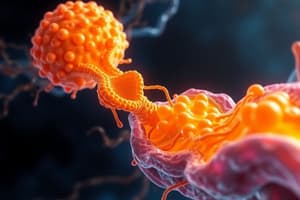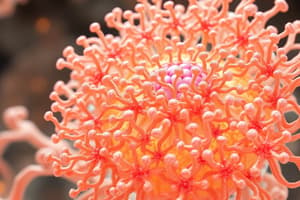Podcast
Questions and Answers
In which of the following cell types is the smooth endoplasmic reticulum most intensively developed?
In which of the following cell types is the smooth endoplasmic reticulum most intensively developed?
- Smooth muscle cell (correct)
- Lymphocytes
- Fibroblasts
- Neurons
Which organelle would you expect to be most highly developed in a cell with high energy (ATP) requirements?
Which organelle would you expect to be most highly developed in a cell with high energy (ATP) requirements?
- Centrioles
- Rough endoplasmic reticulum
- Peroxisome
- Mitochondria (correct)
What are cells with large amounts of rough endoplasmic reticulum most likely to produce?
What are cells with large amounts of rough endoplasmic reticulum most likely to produce?
- Synthesize a protein-secretory product
- Steroid hormones (correct)
- Line the lumen of blood vessels
- Produce structural proteins that remain in the cell
Which intercellular junctional mechanism is responsible for cells being electrically coupled?
Which intercellular junctional mechanism is responsible for cells being electrically coupled?
What are the functions of the Golgi complex?
What are the functions of the Golgi complex?
What type of dye is eosin?
What type of dye is eosin?
What does hematoxylin stain in the cell?
What does hematoxylin stain in the cell?
What is basophilia?
What is basophilia?
What does glycocalyx consist of?
What does glycocalyx consist of?
Where is glycocalyx located?
Where is glycocalyx located?
Which of the following is NOT a component of the plasma membrane?
Which of the following is NOT a component of the plasma membrane?
Which of the following is NOT found on the external surface of the cell membrane?
Which of the following is NOT found on the external surface of the cell membrane?
In the context of vesicular transport, what is the function of endocytosis?
In the context of vesicular transport, what is the function of endocytosis?
What is the function of cells with microvilli?
What is the function of cells with microvilli?
What forms lysosomes within the cell?
What forms lysosomes within the cell?
Which of the following is NOT associated with endocytosis?
Which of the following is NOT associated with endocytosis?
What process is exocytosis?
What process is exocytosis?
What is NOT present on an internal surface of the cell membrane?
What is NOT present on an internal surface of the cell membrane?
Which one of these is NOT a function of glycosaminoglycans?
Which one of these is NOT a function of glycosaminoglycans?
Which organelle does not consist of 3 cisterns?
Which organelle does not consist of 3 cisterns?
Flashcards are hidden until you start studying
Study Notes
Cell Types and Organelles
- Smooth endoplasmic reticulum (SER) is most intensively developed in steroid hormone-secreting cells and liver cells.
- Mitochondria are the organelles most highly developed in cells with high ATP requirements, as they are the primary site of energy production.
- Cells with large amounts of rough endoplasmic reticulum (RER) are likely to produce significant quantities of proteins, especially those destined for secretion or for lysosomes.
Intercellular Junctions and Cellular Functions
- Gap junctions are responsible for electrically coupling cells, allowing direct communication through ion and small molecule passage.
- The Golgi complex plays several roles, including modification, sorting, and packaging of proteins for secretion or delivery to other organelles.
Staining and Cellular Components
- Eosin is an acidic dye commonly used in histology to stain cytoplasmic components, creating a pink coloration.
- Hematoxylin stains nucleic acids, particularly the nuclei of cells, giving a bluish-purple hue.
- Basophilia refers to the affinity of certain cell components (like nucleic acids) for basic (alkaline) dyes, indicating high RNA or DNA content.
Glycocalyx Structure and Function
- Glycocalyx is composed of glycoproteins, glycolipids, and carbohydrates, creating a protective and functional layer on the cell surface.
- Located on the external surface of the plasma membrane, glycocalyx plays a role in cell recognition, protection, and adhesion.
Plasma Membrane Components
- Cholesterol is crucial to plasma membrane fluidity; however, cell organelles (like ribosomes) are NOT components of the plasma membrane.
- Carbohydrates, particularly glycoproteins and glycolipids, are NOT typically present on the internal surface of the cell membrane.
Transport Mechanisms
- Endocytosis is a process that enables the uptake of extracellular substances into the cell by engulfing them in membrane-bound vesicles.
- Microvilli increase surface area for absorption and are prominent in epithelial cells of the intestines or kidneys.
- Lysosomes are formed from the fusion of transport vesicles containing hydrolytic enzymes that break down waste materials.
Exocytosis and Glycosaminoglycans
- Exocytosis is the process of transporting materials out of the cell through vesicular transport that fuses with the plasma membrane.
- Glycosaminoglycans, despite their various functions, do not primarily serve as a source of energy storage for cells.
Organelle Structures
- Rough endoplasmic reticulum is characterized by ribosomes on its surface, but the mitochondria do not consist of three cisterns like the Golgi apparatus does.
Studying That Suits You
Use AI to generate personalized quizzes and flashcards to suit your learning preferences.




